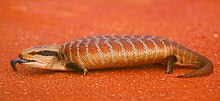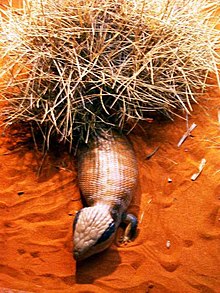
Skinks are lizards belonging to the family Scincidae, a family in the infraorder Scincomorpha. With more than 1,500 described species across 100 different taxonomic genera, the family Scincidae is one of the most diverse families of lizards. Skinks are characterized by their smaller legs in comparison to typical lizards and are found in different habitats except arctic and subarctic regions.

The pink-tongued skink is a species of lizard in the family Scincidae. It is endemic to Australia, where it is also called commonly the pink-tongued lizard. As suggested by these common names, its distinguishing characteristic is a pink tongue as opposed to the blue tongue of lizards of the closely related genus Tiliqua.

Blue-tongued skinks comprise the Australasian genus Tiliqua, which contains some of the largest members of the skink family (Scincidae). They are commonly called blue-tongued lizards or simply blue-tongues or blueys in Australia or panana in Indonesia. As suggested by these common names, a prominent characteristic of the genus is a large blue tongue that can be bared as bluff-warning to potential enemies. The type of predator/threat that is near will determine the intensity of colour present in the tongue. The tongue can also deform itself and produce a thick mucus in order to catch prey. They are relatively shy in comparison with other lizards, and also significantly slower due to their shorter legs.
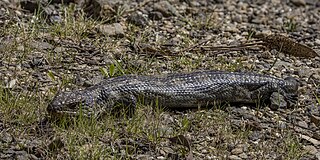
The blotched blue-tongued lizard, also known as the southern blue-tongued lizard or blotched blue-tongued skink is a blue-tongued skink endemic to south-eastern Australia.

Tiliqua rugosa, most commonly known as the shingleback skink or bobtail lizard, is a short-tailed, slow-moving species of blue-tongued skink endemic to Australia. It is commonly known as the shingleback or sleepy lizard. Three of its four recognised subspecies are found in Western Australia, where the bobtail name is most frequently used. The fourth subspecies, T. rugosa asper, is the only one native to eastern Australia, where it goes by the common name of the eastern shingleback.

The Tiliqua scincoides scincoides, or eastern blue-tongued lizard, is native to Australia. Its blue tongue can be used to warn off predators. In addition to flashing its blue tongue, the skink hisses and puffs up its chest to assert dominance and appear bigger when in the presence of its predators such as large snakes and birds. The eastern blue tongue is ovoviviparous and precocial, meaning that its young are more developed and advanced at their time of birth. The Tiliqua scincoides scincoides is not venomous to humans and can be found in suburban and urban areas, specifically in house gardens.

Cunningham's spiny-tailed skink, also known commonly as Cunningham's skink, is a species of large skink, a lizard in the family Scincidae. The species is native to southeastern Australia.

The western blue-tongued lizard, also known as the western blue-tongued skink, is a large skink native to Australia. It is one of six species of blue-tongued skinks found in Australia, though further species are found in New Guinea and Indonesia.

The northern blue-tongued skink or northern blue-tongued lizard is the largest and heaviest of the blue-tongued lizards. They are native to Australia and found almost exclusively in the Northern Region. They generally live around 20 years and are commonly kept as pets.
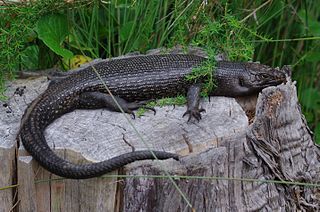
King's skink is a species of skink, a lizard in the family Scincidae. The species is endemic to Australia.

The Adelaide pygmy blue-tongue skink or pygmy bluetongue is a species of skink, a lizard in the family Scincidae. The species was previously thought to be extinct and only rediscovered in 1992. Known locations of the species extend from Kapunda in the Light River valley, about 77 kilometres (48 mi) north east of Adelaide, northwards to Peterborough, about 254 kilometres (158 mi) north of Adelaide.
The western limestone ctenotus is a species of skink, a lizard in the family Scincidae. The species is endemic to Australia.

The Indonesian blue-tongued skink is a lizard in the family Scincidae. It is a close relative of the eastern blue-tongued lizard. They are endemic to the island of New Guinea and other various surrounding islands. They are found typically in the rainforest, and in captivity, require high humidity. In comparison to Tiliqua scincoides, they are fairly lean. They also have long tails.

Tiliqua scincoides is a species of skink. It is native to Australia as well Tanimbar Island.

Ctenotus strauchii, also known commonly as the eastern barred wedge-snout ctenotus or Strauch's ctenotus, is a small species of lizard in the family Scincidae. The species is endemic to Australia and is found throughout semi-arid and arid regions in most of Australia's mainland states except Western Australia, although one record does exist for Western Australia in 1975.
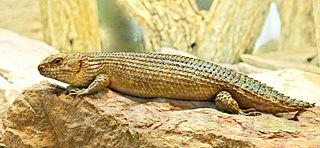
Egernia stokesii is a gregarious species of lizard of the Scincidae family. This diurnal species is endemic to Australia, and is also known as the Gidgee skink, spiny-tailed skink, Stokes's skink and Stokes's egernia. The species forms stable, long-term social aggregations, much like the social groups seen in mammalian and avian species. This characteristic is rarely found in the Squamata order, but is widespread within the Australian subfamily of Egerniinae skinks. Populations of E. stokesii are widely distributed, but fragmented, and occur in semi-arid environments. There are three recognised subspecies. The conservation status for the species is listed as least concern, however, one subspecies is listed as endangered.

The black rock skink is a species of large skink native to Eastern and Southern Australia from central New South Wales to Grampians National Park in Victoria. A large, dark colored skink, up to 135 mm from snout to base of the tail, the black rock skink is the first reptile discovered to have a "nuclear family" structure where the parents form a pair and care for their offspring for more than one year. The black rock skink is a viviparous skink meaning females give birth to live offspring instead of laying eggs. They defend their home range and families against conspecifics for up to several years.
The saltbush slender bluetongue is a species of lizard in the family Scincidae. The species is endemic to the arid interior of eastern Australia. Although its conservation status is of least concern, it has been listed as endangered in New South Wales. The slender saltbush bluetongue has been recorded in Sturt National Park in New South Wales but extends into northeast South Australia and south-west Queensland.

Crocosaurus Cove is a crocodile herpetarium and aquarium zoo located in an indoor complex in the city district of Darwin, Northern Territory, Australia. Its main focus as the facility's name indicates is the tourism drawcard of the crocodiles of northern Australia. The park has a considerable number of saltwater crocodiles including 700kg and 5.1 metre long male Burt, who appeared in 1986 movie Crocodile Dundee and made news in 2018 for 'psychic predictions' outcomes of the 2018 Soccer World Cup by reaching up and grabbing photographs of players which was seen as match and player performance 'predicting'. The facility has also had success with breeding and hatching baby crocodiles including in July 2022 with baby crocodiles hatched to parent crocodiles female Kate and male William. One of the things most well known at the facility which significantly increased visitor numbers is a 'cage of death' experience where paying visitors can swim in water with large crocodiles while protected from physical contact with them by being enclosed behind a glass safety dome. As previously mentioned a significant number of other native Australian reptiles are also kept at the facility and publicly exhibited. Mick Burns the owner is also owner of Darwin Crocodile Farm.
The Spinifex slender blue-tongue or Samphire slender bluetongue is an endemic species of skink that inhabits the arid areas of central Australia. The Spinifex slender blue-tongue is closely related to the large blue-tongue skinks. However is individually categorised under the Genus Cyclodomorphus and species Cyclodomorphus melanops(C. melanops).
